#Industrial neodymium magnets
Text
Exploring the rich potential of copper and rare earth elements
Exploring the rich potential of copper and rare earth elements: A deep dive into Rincon Resources’ West Arunta project
Rincon Resources’ exploration of Australia’s newest critical mineral province, the West Arunta Region, has yielded highly promising results thus far.
Rincon Resources is an Australian minerals exploration company with a keen eye on Western Australia’s mineral-rich landscapes,…

View On WordPress
#industrial magnets#Industrial neodymium magnets#magnet applications#Magnetic Application#Magnetic Materials#Magnets Application#Neodymium magnets#rare earth application#rare earth element#Rare Earth Magnet Recycling#Rare Earth Magnets#rare earths#rare earths project#recycling magnets#Recycling Neodymium Magnets
0 notes
Text
How Magnets Work
How Magnets Work
You probably know that magnets attract specific metals and they have north and south poles. Opposite poles attract each other while like poles repel each other. Magnetic and electrical fields are related, and magnetism, along with gravity and strong and weak atomic forces, is one of the four fundamental forces in the universe.
But none of those facts answers the most basic…
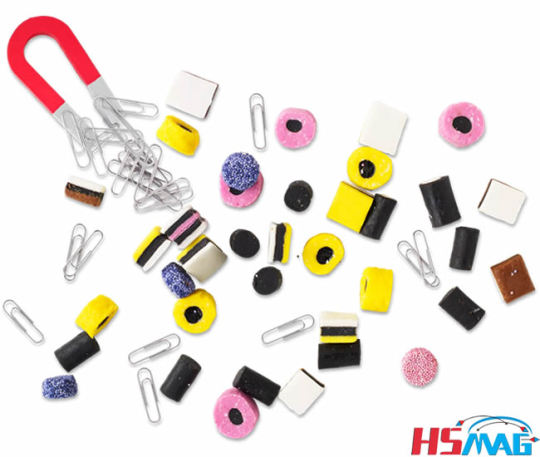
View On WordPress
#Alnico magnets#Ceramic magnets#Ferrites magnets#Industrial Magnetics#Magnet Strength#magnetic materials#magnetic performances#Magnetics technology#Making Magnets#Neodymium magnets#permanent magnet materials#permanent magnetic materials#permanent magnets#powerful magnets#regular magnets#Samarium Cobalt magnets#Shipping Magnets
0 notes
Text
Brazil starts to tap its rare earth reserves
A rare earth mining project nearing completion in the midwestern state of Goiás has the potential to kickstart the development of a rare earth industry in Brazil, market participants said

The Mineração Serra Verde project, owned by energy transition-focused private equity firm Denham Capital, is in the final stages of commissioning and is scheduled to launch ionic clay rare earth production by the end of this year.
Planned phase 1 output is large by industry standards, at around 5,000 tonnes per year of rare earth oxides contained in concentrate. Importantly, this will include both the light rare earths neodymium and praseodymium and the heavy rare earths dysprosium and terbium, which are all needed for high-performance neodymium iron boron (NdFeB) magnets for the engines of electric vehicles (EVs).
Neodymium and praseodymium are used in the largest amount in NdFeB magnets, but trace quantities of dysprosium and terbium are critical for maintaining the performance of these magnets at high temperatures inside an EV engine.
Global production of heavy rare earth ores is concentrated in Myanmar, and supply is frequently disrupted. This is accelerating the search for new sources of supply to meet growing demand from the automotive sector.
Continue reading.
3 notes
·
View notes
Text
For most of the history of civilisation we’ve exploited a pretty small selection of metals, including copper and tin for bronze-age tools, iron for steel, and lead, gold and silver. Our repertoire has begun to diversify over the past century or so, with the widespread use of aluminium and other new metals. But in the past few decades the number of different metals we wield in our technological society has absolutely exploded. A modern smartphone contains more than 30 different elements. These include carbon and hydrogen in the plastic casing, silicon for the microchip wafers, and copper wiring and gold contacts. But there are also small amounts of a large number of other metals, each exploited for its own particular electronic properties, or for the tiny, powerful magnets used in the speaker and vibration motor. This means that if you own a smartphone, you have in your pocket a substantial fraction of all the stable elements of the periodic table. And it’s not just modern electronics that demand a huge diversity of different metals. So too do the high-performance alloys used in the turbines of a power station or aircraft jet engine, or the reaction-accelerating catalysts that we use in industrial chemistry for refining oil, producing plastics or synthesising modern medicinal drugs. Yet most of us have never even heard of many of these critical metals – elements with exotic names like tantalum, yttrium or dysprosium.
The concern is that unlike widespread resources like iron or nitrogen, several of these elements crucial to the modern world may become prohibitively scarce. These have become known as the endangered elements. In response to the Mendeleev anniversary, the European Chemical Society (EuChemS) has released a version of the periodic table (see above) to highlight the elements that are most at risk over the coming decades.
Helium, for example is considered to be under serious threat in the next 100 years. It is the second most abundant element in the universe, but preciously rare on Earth because it is light enough to simply escape from the top of our atmosphere. The helium we do use is effectively mined from deep underground, usually along with natural gas, as it is produced as radiation particles from the decay of elements like uranium. Helium is very useful – as a cooling liquid for the superconducting magnets in hospital MRI scanners, for example, or as an extremely light gas for weather balloons and airships. But once it leaks into the air it is lost for ever, and there are concerns over meeting supply in the future. With this perspective, its frivolous use in party balloons seems almost painfully wasteful.
Many of these endangered elements are the sort of exotic metals used in modern electronics, and indeed the supply of 17 elements needed for smartphones may give cause for concern in years to come. Particularly worrying is the fact that many of those facing potential scarcity are exactly the elements we need for the green technologies to replace our reliance on fossil fuels – those used in rechargeable batteries, solar panels, and the powerful magnets within the motors of electric cars or generators in wind turbines. Gallium, for example, is needed for integrated circuits, solar panels, blue LEDs and laser diodes for Blu-ray Discs. Indium is used in everything from TVs to laptops, and in particular the touch-sensitive screens of modern smartphones and tablets. It is estimated that at current usage rates, available indium will be used up in 50 years and will become very expensive to collect and purify.
Except for helium, the problem isn’t that these scarce elements actually become lost to the planet, but that they become too expensive to mine or too dispersed to recycle effectively. “Rare earth elements”, such as yttrium, dysprosium, neodymium and scandium, are actually relatively plentiful in the Earth’s crust but aren’t geologically concentrated into rich ores. This means that they can’t be extracted economically in many areas of the world. And once they have been manufactured as tiny components within an electronic device, they can be even harder to reclaim and recycle. EuChemS calculates that 10m smartphones are discarded or replaced every month in the EU alone, and so serious action is needed to tackle these challenges of elemental scarcity.
#current events#environmentalism#capitalism#manufacturing#science#chemistry#mining#tantalum#yttrium#dysprosium#helium#indium#neodymium#scandium#dmitri mendeleev#periodic table
6 notes
·
View notes
Text
Magnet Market increase by USD 17.54 billion, at a CAGR of 7.89% between 2023 and 2028
Magnet Market Size 2024-2028
The magnet market is expected to grow by USD 17.54 billion, with a CAGR of 7.89% from 2023 to 2028. Magnets, materials with a magnetic field that attract iron, nickel, cobalt, and similar metals, are primarily composed of ferromagnetic metals such as nickel and iron. This market growth is driven by increasing demand in the automobile sector, the growing need for defense aircraft, rising government defense expenditures, and the expanding application of magnets in storage technology. Our report analyzes historical data from 2018-2022 and examines the current market scenario.
Market Forecast and Size
The magnet market is influenced by several factors, including GDP growth, inflation, and government purchases. Rising consumer spending and investments in business and inventory have led to increased demand for magnets across various sectors, including industrial applications and automotive segments. Magnets are essential components in products like computer cables, DVDs, and mobile phones. Regulatory authorities also impact market dynamics through residue management and mining licenses. Key magnet types include neodymium iron boron (NdFeB), ferrite, and alnico, which are crucial in electric motors and voice coil motors.
Download Magnet Market Sample PDF Report
Market Segmentation
Type:
Ferrite: Widely used in industrial applications for their high magnetic strength and durability, ferrite magnets are common in fax stepper motors, printer machine rollers, and automotive components.
External Suppliers: These magnets find applications in consumer electronics, including recorders, cameras, watches, and earbuds, due to their lightweight and efficient properties.
Application:
Industrial: Magnets are essential in machinery and equipment for efficient operations and precise control.
Consumer Electronics: Utilized in products like smartphones and personal electronics, driving significant demand.
Type Insights
Permanent Magnets: Expected to see significant growth, permanent magnets are made from special alloys like nickel, samarium cobalt, and iron. These magnets retain their magnetic properties even when removed from the magnetic field. The automotive industry, particularly in developing nations, drives this segment, which was valued at USD 21.73 billion in 2018.
End-user Insights
Consumer Goods and Electronics: This segment will account for the largest market share. Major consumers include China, Japan, South Korea, and India in APAC, followed by the US and Canada in North America, and the UK and Germany in Europe. Magnets are crucial in devices like hard drives, earphones, and microphones.
Regional Insights
APAC: Expected to contribute 44% to global market growth, driven by rapid industrialization and expansions in automotive, industrial, energy, and consumer electronics sectors. The demand for permanent magnets in consumer electronics is increasing due to rising disposable incomes and improved living standards. Applications include air conditioners, washing machines, computers, and loudspeakers.
Market Dynamics and Customer Landscape
The magnet market is growing steadily, influenced by factors such as increased consumer spending and demand for industrial and automotive applications. Innovations and supply-demand balance play crucial roles. The market benefits from the increased applicability of magnets in storage technology and the use of nanocrystalline magnetic particles in the biomedical industry. However, high R&D costs present a significant challenge.
Key Market Drivers
Storage Technology: Magnets enable compact, lightweight, and efficient energy storage systems, making them ideal for integrating renewable energy sources into power grids.
Nanocrystalline Magnetic Particles: Their use in the biomedical industry, particularly in sensors, biosensors, MRI scanners, and drug delivery, is shaping market growth.
Download Magnet Market Sample PDF Report
Major Market Challenges
High R&D Costs: Developing novel and advanced magnet materials requires significant financial resources, qualified personnel, and extensive laboratory facilities.
Customer Landscape
The market report includes the adoption lifecycle, focusing on different regional penetration rates. It also covers key purchase criteria and price sensitivity drivers, helping companies evaluate and develop their growth strategies.
Key Companies
Key players implement various strategies such as alliances, partnerships, mergers and acquisitions, geographical expansion, and product/service launches. The report includes detailed competitive landscape analyses and information about 20 companies, including Adams Magnetic Products, Arnold Magnetic Technologies Corp., Daido Steel Co. Ltd., and TDK Corp.
Conclusion
The magnet market is poised for robust growth, driven by diverse applications across sectors like automotive, consumer electronics, and industrial applications. Despite challenges like high R&D costs, the increasing demand for efficient, reliable, and versatile magnet solutions will continue to propel market expansion during the forecast period.
Download Magnet Market Sample PDF Report
0 notes
Text
Neodymium Speaker wholesaler
ATI Pro Audio stands as a distinguished name in the audio industry, renowned for its extensive selection of speakers and sound systems. As a premier supplier, wholesaler, and importer of Neodymium Speaker, utilizes neodymium magnets, enhancing audio performance with its lightweight yet powerful design. Delivering crisp highs, rich mids, and deep bass, it's favored for its efficiency and fidelity, ideal for audio aficionados and professionals alike. Its compact size and robust construction make it a versatile choice for various applications.
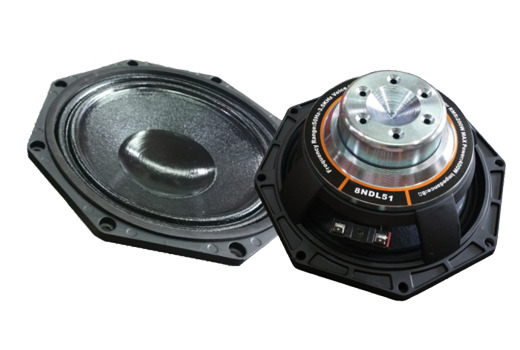
0 notes
Text
ATI Pro Best Neodymium DJ Speakers
ATI Pro Audio is a distinguished name in the audio industry, renowned for its extensive selection of speakers and sound systems. We specialize in offering top-tier sound solutions at competitive prices. Best neodymium dj speaker India utilizes neodymium magnets, enhancing audio performance with its lightweight yet powerful design. Delivering crisp highs, rich mids, and deep bass, it's favored for its efficiency and fidelity, ideal for audio aficionados and professionals alike. Its compact size and robust construction make it a versatile choice for various applications.
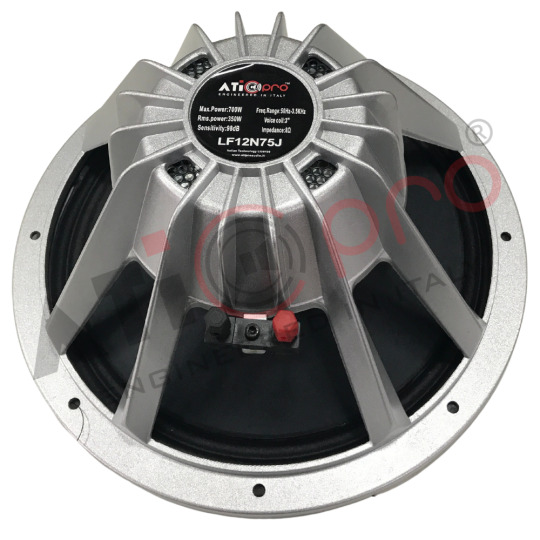
0 notes
Text
Unlocking Growth: Exploring the IE4 Permanent Magnet Synchronous Motor Market
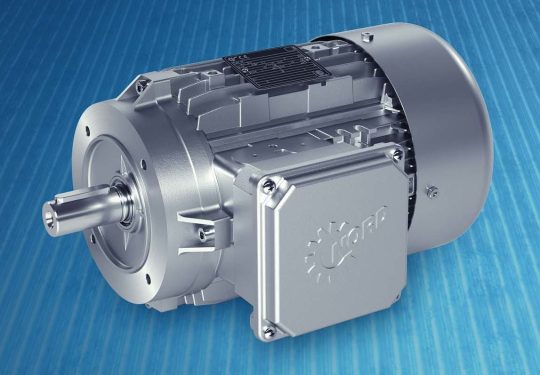
The global economy is undergoing a significant shift towards sustainability and energy efficiency, driven by environmental concerns and regulatory mandates. In this transformative landscape, the IE4 Permanent Magnet Synchronous Motor (PMSM) market has emerged as a critical enabler of progress. According to a study by Next Move Strategy Consulting, the global IE4 Permanent Magnet Synchronous Motor Market size is predicted to reach USD 308.6 million with a CAGR of 8.97% by 2030. This underscores the growing importance of these advanced electric motors in various industries worldwide.
Request for a sample, here: https://www.nextmsc.com/ie4-permanent-magnet/request-sample
Understanding IE4 Permanent Magnet Synchronous Motors:
IE4 Permanent Magnet Synchronous Motors represent a paradigm shift in electric motor technology. Unlike conventional motors that rely on electromagnetic induction, PMSMs utilize permanent magnets to generate magnetic fields, resulting in higher efficiency, precision control, and reduced energy consumption. These motors are characterized by their synchronous operation, where the rotor rotates at the same speed as the magnetic field produced by the stator, enabling precise speed control and torque regulation.
Key Drivers of Market Growth:
The growth of the IE4 Permanent Magnet Synchronous Motor market is driven by several key factors. Firstly, stringent environmental regulations aimed at reducing carbon emissions and improving energy efficiency have prompted industries to adopt eco-friendly technologies, including high-efficiency electric motors. IE4 PMSMs offer significant energy savings compared to traditional motors, making them an attractive choice for applications where energy efficiency is paramount.
Moreover, the rapid expansion of industrial automation and the adoption of smart manufacturing technologies have fueled the demand for high-performance motors capable of delivering optimal efficiency and reliability. IE4 PMSMs are well-suited for use in robotics, CNC machines, conveyor systems, and other automated processes, where precision control and high torque density are essential.
Furthermore, the growing adoption of electric vehicles (EVs) and hybrid vehicles is driving demand for IE4 PMSMs in the automotive sector. These motors play a crucial role in powering electric propulsion systems, offering superior efficiency, power density, and torque characteristics compared to traditional internal combustion engines. As governments worldwide implement policies to reduce vehicle emissions and promote electric mobility, the demand for IE4 PMSMs in the automotive industry is expected to surge in the coming years.
Challenges and Opportunities:
Despite the promising growth prospects, the IE4 Permanent Magnet Synchronous Motor market faces several challenges. One of the primary challenges is the high initial cost associated with these motors, primarily due to the use of rare-earth magnets such as neodymium and dysprosium. The limited availability of these materials and their fluctuating prices pose a significant risk to manufacturers and end-users alike. However, ongoing research and development efforts aimed at alternative magnet materials, such as ferrite and samarium cobalt, are expected to mitigate this challenge in the long term.
Additionally, the complexity of motor design and integration presents challenges in terms of manufacturing, installation, and maintenance. IE4 PMSMs require sophisticated control systems and advanced manufacturing techniques to achieve optimal performance and efficiency. Moreover, the customization requirements for different applications and industries add further complexity to the production process, potentially increasing lead times and costs.
Despite these challenges, the IE4 Permanent Magnet Synchronous Motor market presents significant opportunities for growth and innovation. The emergence of new applications and industries, such as renewable energy, robotics, and IoT, is driving demand for high-performance motors with enhanced efficiency, reliability, and durability. For instance, the rise of wind and solar power generation has created a growing need for IE4 PMSMs in wind turbines, solar tracking systems, and grid stabilization solutions. Similarly, the integration of robotics and IoT technologies in manufacturing, logistics, and healthcare sectors is driving demand for IE4 PMSMs in robotic arms, automated guided vehicles (AGVs), and medical devices.
Adoption Challenges in Traditional Industries: Despite the advantages of IE4 Permanent Magnet Synchronous Motors, the adoption rate in traditional industries such as HVAC, pumping systems, and material handling equipment has been relatively slow. This can be attributed to factors such as entrenched reliance on conventional motor technologies, lack of awareness about the benefits of PMSMs, and concerns about compatibility with existing infrastructure. Overcoming these adoption challenges will require targeted education and awareness campaigns, along with incentivization programs to encourage businesses to transition to more energy-efficient motor solutions.
Regulatory Compliance and Standards: Compliance with industry standards and regulations poses another challenge for the IE4 Permanent Magnet Synchronous Motor market. Manufacturers must ensure that their products meet stringent performance, safety, and efficiency standards set forth by regulatory bodies and industry associations. Failure to comply with these standards can result in costly recalls, penalties, and damage to brand reputation. Therefore, investing in research and development to develop motors that not only meet but exceed regulatory requirements will be essential for gaining a competitive edge in the market.
Inquire before buying, here: https://www.nextmsc.com/ie4-permanent-magnet/inquire-before-buying
Supply Chain Vulnerabilities: The IE4 Permanent Magnet Synchronous Motor market is susceptible to supply chain disruptions, particularly concerning the procurement of rare-earth magnets and other critical components. Dependence on a limited number of suppliers, geopolitical tensions, and trade restrictions can lead to shortages, price fluctuations, and delays in production. To mitigate supply chain vulnerabilities, manufacturers must diversify their supplier base, invest in vertical integration, and explore alternative sourcing options to ensure a reliable and resilient supply chain.
Technological Innovation and Advancements: Continuous technological innovation is imperative for driving growth and differentiation in the IE4 Permanent Magnet Synchronous Motor market. Manufacturers must invest in research and development to enhance motor efficiency, reliability, and performance while reducing costs and environmental impact. Advancements in materials science, motor design, power electronics, and digital control systems offer opportunities to develop next-generation PMSMs that meet the evolving needs of industries and consumers alike.
Lifecycle Sustainability and End-of-Life Management: Ensuring the sustainability of IE4 Permanent Magnet Synchronous Motors throughout their lifecycle presents both challenges and opportunities for manufacturers. From raw material extraction to manufacturing, use, and end-of-life disposal, minimizing environmental impact and maximizing resource efficiency are paramount. Implementing circular economy principles, such as remanufacturing, recycling, and responsible disposal, can help reduce waste and extend the lifespan of PMSMs, thereby contributing to a more sustainable and circular economy.
Market Fragmentation and Competition: The IE4 Permanent Magnet Synchronous Motor market is characterized by intense competition and market fragmentation, with numerous players vying for market share across different regions and industry verticals. As a result, manufacturers must differentiate their products through innovation, quality, and value-added services to stand out in the crowded marketplace. Strategic partnerships, mergers and acquisitions, and market consolidation may also be necessary to strengthen market position and achieve economies of scale.
Skills Gap and Talent Shortage: Addressing the skills gap and talent shortage in the IE4 Permanent Magnet Synchronous Motor industry is essential for driving innovation and sustaining market growth. As technology advances and the demand for specialized skills increases, manufacturers must invest in workforce development, training programs, and knowledge transfer initiatives to cultivate a skilled workforce capable of designing, manufacturing, and servicing advanced PMSM systems. Collaboration with educational institutions, vocational training centers, and industry associations can help bridge the skills gap and ensure a steady supply of talent for the future.
Conclusion:
In conclusion, the IE4 Permanent Magnet Synchronous Motor market is poised for substantial growth and innovation in the coming years. With increasing emphasis on energy efficiency, sustainability, and technological advancement, IE4 PMSMs are expected to play a pivotal role in powering the industries of the future. By leveraging their superior efficiency, reliability, and performance, these advanced electric motors are unlocking new opportunities for growth and transformation across various sectors. However, addressing the challenges associated with cost, materials, and complexity will be crucial for realizing the full potential of IE4 PMSMs and driving widespread adoption. As manufacturers, researchers, and policymakers collaborate to overcome these challenges, the IE4 Permanent Magnet Synchronous Motor market will continue to evolve and thrive, shaping a more sustainable and efficient future for generations to come.
#IE4 Permanent Magnet Synchronous Motor#construction and manufacturing#market research#market trends#business insights
0 notes
Text
From Magnetite to Magnificence: The Role of Magnets in Cape Town on Industries
In Cape Town, which is well-known for its beautiful scenery and rich cultural heritage, magnets play a crucial role in industrial activities. Magnets are essential to many of the city's industries, including manufacturing, technology, and healthcare. This article will examine the various uses of magnets Cape Town on industries, emphasising their importance and influence.
Magnetic Materials & Manufacturing
Magnets are necessary parts of a wide range of products produced in Cape Town's manufacturing sector. Permanent magnets are used in the production of electric motors, generators, and magnetic bearings. They are formed of materials like neodymium, ferrite, and samarium-cobalt. These magnets are also essential for the manufacturing of magnetic actuators and sensors, which are used in the consumer electronics, automotive, and aircraft industries.
Magnets in Technology & Innovation
Cape Town uses magnets in several innovative and technological applications. Strong magnets are used by magnetic resonance imaging (MRI) machines, which are used in medicine to produce precise images of the interior organs. Additionally, the city is home to research and development centres that are investigating novel uses for magnets, such as magnetic records storage and magnetic lifting technologies.
Healthcare & Magnetic Therapy
Magnets are being used therapeutically in Cape Town's healthcare system. The use of magnets to relieve pain and encourage healing is known as magnetic therapy, and it is becoming more popular in the city. Products with magnetic therapy, like mattress pads and bracelets, are used to treat ailments like migraines, back pain, and arthritis. Furthermore, magnets are used in medical equipment like hearing aids and pacemakers.
Environmental Impact & Sustainability
The city of Cape Town is dedicated to environmental preservation and sustainability, and magnets are part of that. Waste management facilities use magnetic separators to extract ferrous materials from waste streams so that valuable materials can be recovered and recycled. In addition, treatment plants for water employ magnets to eliminate impurities from the water, guaranteeing that the city's citizens have a source of safe and clean water to drink.
Economic Growth & Job Creation
Magnets are used in Cape Town's industries to create jobs as well as promote economic growth. The manufacturing and technology industries, which primarily rely on magnets, employ the majority of the city's workforce. With Cape Town's industrial capacity and inventiveness continuing to grow, magnets along with related technologies are going to grow more necessary, which will add even more to the city's economic success.
Magnetic Energy & Power Generation
Magnets are being investigated for their potential applications in energy generation and storage in Cape Town. In generators and turbines, magnets are used to transform mechanical energy into electrical energy. Magnesium batteries are also being studied because they can store a lot of energy to be used during times of high demand. These developments in magnetic technology may facilitate Cape Town's shift away from fossil fuels and towards greener, more sustainable energy sources.
In summary, magnets have a variety of functions in Cape Town's industries, fostering innovation, assisting with sustainability initiatives, and fostering economic expansion. As Cape Town becomes a centre of business activity, the magnets will become more and more significant in the town's industrial landscape.
0 notes
Text
Navigating Regulatory Challenges in the Rare Earth Metals Industry
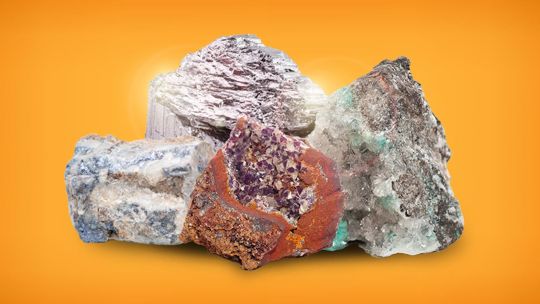
Rare Earth Metals: Essential Yet Scarce Resources Powering Our Digital Age
Rise of RESs Demand
Rare earth metals have become indispensable to the functioning of modern technology and renewable energy infrastructure. These seventeen chemical elements, which include neodymium, cerium, lanthanum, and others, are used in everything from consumer electronics to electric vehicles and wind turbines. Due to their unique magnetic and electrochemical properties, RESs serve as critical components in rechargeable batteries, computer memory, camera lenses, magnets, and more.
As global demand for technology and green energy solutions has surged in recent years, so too has the need for RESs. Smartphones, laptops, and other consumer devices require neodymium, dysprosium, and yttrium to power their miniature motors and precision optics. Electric vehicles incorporate permanent rare earth magnets into their motors and batteries for boosting efficiency. Wind turbines leverage neodymium magnets to generate power from spinning blades.
Supply Chain Vulnerabilities
Though scattered across the planet, over 90% of the world's REB supply is concentrated in China. The country's dominance has left other nations heavily dependent on Chinese exports. However, natural disasters, geopolitical tensions, and unilateral trade actions have periodically disrupted global rare earth supply chains in the past.
For example, in 2010 China reduced its export quotas by 40% following a territorial dispute with Japan. This sent prices skyrocketing by over 700% in a matter of months, battering manufacturers reliant on Chinese exports. Similar export restrictions and quotas imposed by China in the past exacerbated supply issues.
Such disruptions exposed critical vulnerabilities and limited optionality within the rare earth supply system. They drove home the message that stable access to these resources could not be guaranteed solely through Chinese supply.
Demand Outlook
With countries promoting renewable energy and electric vehicles as part of their decarbonization agendas, RESs requirements are poised to multiply in the coming decades. Experts forecast demand could balloon by over 500% by 2050 globally according to some estimates. This potential demand surge threatens to outstrip even optimistic production growth scenarios from mining investments made to date.
Securing long-term access to sufficient rare earth supplies therefore stands as a major strategic priority and competitive issue for both governments and companies racing toward a low-carbon future. As the digital and green technology revolutions continue to reshape economies worldwide, these scarce yet essential minerals will play an outsized role in determining which nations can become leaders
In Summary, china currently dominates the global rare earth metals market, accounting for a significant portion of both production and reserves. However, concerns about supply chain security and environmental sustainability have prompted other countries to explore alternative sources and methods for extracting and recycling RESs.
0 notes
Text
Bonded Magnets Assemblies, Global Market Size Forecast, Top 9 Players Rank and Market Share
Bonded Magnets Assemblies Market Summary
Bonded magnets assemblies are critical magnetic materials known for their excellent magnetic and mechanical properties, finding wide-ranging applications in industries such as automotive, electronics, and medical. Currently, the market for bonded magnets assemblies is substantial, with sales volume steadily increasing. Major uses include motors, sensors, magnetic couplers, magnetic fixtures, and magnetic drive systems. In the future, with the continuous expansion of the electric vehicle market, proliferation of smartphones and electronic devices, and increasing demand for medical equipment, the application scope of bonded magnets assemblies is poised to expand further, offering promising market prospects.
According to the new market research report “Global Bonded Magnets Assemblies Market Report 2023-2029”, published by QYResearch, the global Bonded Magnets Assemblies market size is projected to reach USD 1.73 billion by 2029, at a CAGR of 4.7% during the forecast period.
Bonded Magnets Assemblies Product Picture

Figure. Global Bonded Magnets Assemblies Market Size (US$ Million), 2018-2029

Above data is based on report from QYResearch: Global Bonded Magnets Assemblies Market Report 2023-2029 (published in 2023). If you need the latest data, plaese contact QYResearch.
Figure. Global Bonded Magnets Assemblies Top 9 Players Ranking and Market Share (Ranking is based on the revenue of 2022, continually updated)
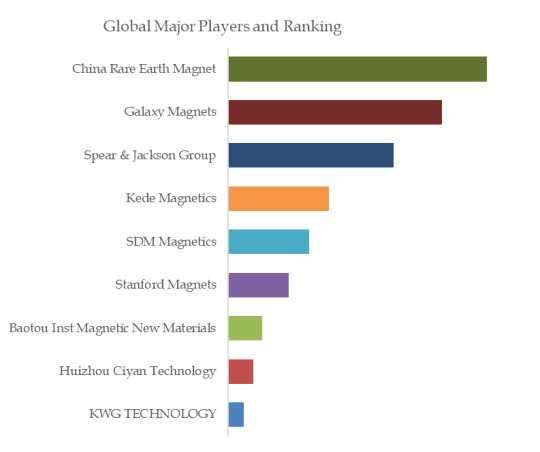
Above data is based on report from QYResearch: Global Bonded Magnets Assemblies Market Report 2023-2029 (published in 2023). If you need the latest data, plaese contact QYResearch.
According to QYResearch Top Players Research Center, the global key manufacturers of Bonded Magnets Assemblies include China Rare Earth Magnet, Galaxy Magnets, etc. In 2022, the global top three players had a share approximately 44.0% in terms of revenue.
Figure. Bonded Magnets Assemblies, Global Market Size, Split by Product Segment
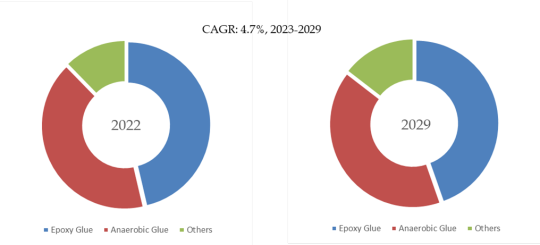
Based on or includes research from QYResearch: Global Bonded Magnets Assemblies Market Report 2023-2029.
In terms of product type, currently Epoxy Glue is the largest segment, hold a share of 46.3%.
Figure. Bonded Magnets Assemblies, Global Market Size, Split by Application Segment
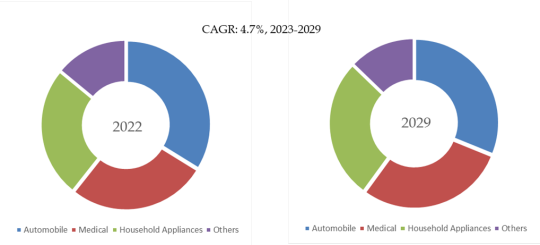
Based on or includes research from QYResearch: Global Bonded Magnets Assemblies Market Report 2023-2029.
In terms of product application, currently Automobile is the largest segment, hold a share of 33.8%.
Market Drivers:
Increasing demand for miniaturization and lightweight components in various industries such as automotive, electronics, and renewable energy is driving the growth of bonded magnets assemblies. These magnets offer flexibility in design and can be tailored to specific application requirements, making them ideal for compact and efficient solutions.
Advancements in bonding technologies and material formulations have led to improved performance and durability of bonded magnets assemblies, enhancing their suitability for diverse applications. This includes enhanced magnetic properties, temperature stability, and corrosion resistance, expanding their adoption across industries.
Restraint:
Limitations in magnetic strength and operating temperature compared to traditional magnet types such as neodymium magnets may restrict the applicability of bonded magnets assemblies in certain high-performance applications.
Cost considerations associated with the manufacturing process of bonded magnets assemblies, including materials, equipment, and labor costs, may pose a restraint for some industries, particularly those with stringent budget constraints.
Opportunity:
Growing emphasis on sustainability and environmental regulations is driving the demand for eco-friendly magnet solutions. Bonded magnets assemblies, which can be produced with recyclable materials and manufacturing processes, present an opportunity for manufacturers to meet sustainability goals and regulatory requirements.
Expansion of applications in emerging industries such as electric vehicles (EVs), renewable energy systems, and consumer electronics provides significant growth opportunities for bonded magnets assemblies. Their lightweight, corrosion-resistant, and customizable nature make them well-suited for these evolving markets.
About QYResearch
QYResearch founded in California, USA in 2007.It is a leading global market research and consulting company. With over 16 years’ experience and professional research team in various cities over the world QY Research focuses on management consulting, database and seminar services, IPO consulting, industry chain research and customized research to help our clients in providing non-linear revenue model and make them successful. We are globally recognized for our expansive portfolio of services, good corporate citizenship, and our strong commitment to sustainability. Up to now, we have cooperated with more than 60,000 clients across five continents. Let’s work closely with you and build a bold and better future.
QYResearch is a world-renowned large-scale consulting company. The industry covers various high-tech industry chain market segments, spanning the semiconductor industry chain (semiconductor equipment and parts, semiconductor materials, ICs, Foundry, packaging and testing, discrete devices, sensors, optoelectronic devices), photovoltaic industry chain (equipment, cells, modules, auxiliary material brackets, inverters, power station terminals), new energy automobile industry chain (batteries and materials, auto parts, batteries, motors, electronic control, automotive semiconductors, etc.), communication industry chain (communication system equipment, terminal equipment, electronic components, RF front-end, optical modules, 4G/5G/6G, broadband, IoT, digital economy, AI), advanced materials industry Chain (metal materials, polymer materials, ceramic materials, nano materials, etc.), machinery manufacturing industry chain (CNC machine tools, construction machinery, electrical machinery, 3C automation, industrial robots, lasers, industrial control, drones), food, beverages and pharmaceuticals, medical equipment, agriculture, etc.
0 notes
Text
Magnetic neighbor effect and interfacial charge transfer induced layered ferromagnetic structures
Magnetic neighbor effect and interfacial charge transfer induced layered ferromagnetic structures
Source: Institute of Physics, Academy of Sciences
As a typical correlated electron system, perovskite nickel oxide exhibits a series of rich physical properties such as metal-insulator phase transition and topological phase transition. Recently, due to the successive discoveries of 112-phase and…

View On WordPress
#industrial magnets#Industrial neodymium magnets#magnet applications#Magnetic Application#Magnetic Materials#Magnets Application#Neodymium magnets#rare earth application#rare earth element#Rare Earth Magnet Recycling#Rare Earth Magnets#rare earths#rare earths project#recycling magnets#Recycling Neodymium Magnets
0 notes
Text
Custom NdFeB Magnets
NdFeB magnets, also known as the "King of Permanent Magnets", is one of the most significant members of the rare earth magnet family. Sintered NdFeB is a rare earth permanent magnet material produced by powder metallurgy. NdFeB magnets can be customized varying from size, shape, magnetic direction to coating according to specific needs and applications by customers.
Different Types of NdFeB Magnets
Sintered NdFeB Magnets
These are the most powerful commercialized permanent magnets available today, with maximum energy product ranging from series of N, M, H, SH, UH, EH to AH.
Magnet Assembly
This refers to components that incorporate magnets, often designed to optimize the magnetic circuit for maximum performance. Magnetic components are finished or semi-finished permanent magnets or other parts composed of one or more magnetic materials. Components typically use adhesives to bond small components together to achieve certain functions that independent magnets cannot achieve. Magnetic components not only enhance the strength of the magnetic field, but also reduce eddy currents and provide good protection for fragile magnets. They can be used in a variety of applications including wind power, industrial automation, automotive industries, home appliances and etc.
Non-sintered NdFeB Magnets
ALNICO magnets are made from an alloy of aluminum, nickel, and cobalt, known for their excellent temperature stability and high residual induction. SMCO NdFeB magnets, made from samarium, cobalt, neodymium, iron, and boron, are powerful rare-earth magnets with high magnetic energy. Ferrite magnets, made from iron oxide and other metals, are cost-effective and have good resistance to demagnetization.
Quality Assurance
At Ningbo Ketian Magnet Co., Ltd., quality assurance is at the heart of our operations. Since 2001, we have been committed to producing high-grade sintered NdFeB magnets, consistently improving our product quality through technical innovation, lean production, and intelligent manufacturing. As a reliable NdFeB magnets factory, our dedication to quality has earned us trust from customers globally, reinforcing our position as a leading magnet manufacturer.
What Are the Applications of Neodymium Magnets?
Neodymium magnets, the most powerful permanent magnets, known for their strong magnetic properties, are widely used in various industries such as electric and hybrid vehicles, home appliances, industrial automation, wind turbines, and consumer electronics, contributing to improved performance and efficiency.

0 notes
Link
0 notes
Text
Best Places to Magnet Fish in the USA

Best Places to Magnet fishing is a recreational activity that involves using a strong magnet attached to a rope to search for metal objects submerged in bodies of water, such as lakes, rivers, canals, or ponds. Similar to traditional fishing, participants cast their magnet into the water and then retrieve it, hoping to attract and pull up metallic objects that may be hidden below the surface.
The magnet used in magnet fishing is typically a neodymium magnet, known for its strong magnetic properties. As the magnet is dragged through the water, it attracts ferrous objects, such as coins, jewelry, tools, and even larger items like bicycles or firearms.
Magnet fishing enthusiasts enjoy the thrill of the hunt and the excitement of uncovering lost or forgotten items. It's also an eco-friendly activity, as it helps remove metal waste from bodies of water, contributing to environmental preservation.
However, it's important to note that while magnet fishing can be an enjoyable and rewarding hobby, participants should always be mindful of local regulations and safety precautions to ensure a positive and responsible experience.
Table of Contents- Places to Magnet Fish in East Coast, USA
- Places to Magnet Fish in the West Coast, USA
- Places to Magnet Fish in Midwest USA
- Places to Magnet Fish in South USA
- Other popular sites for magnet fishing in the USA
- Rules and Regulations for Fishing
https://www.youtube.com/watch?v=sVQM1F7M9bM
Credit: (12) BobbyGuyFilms - YouTube
Places to Magnet Fish in East Coast, USA
Chesapeake Bay, Maryland
It is a diverse landscape for fishing and many places where you can do magnet fishing. If you look for piers, docks, and bridges along the bay for potential magnet fishing spots, then you must visit Chesapeake Bay, Maryland for magnet fishing.
You can consider magnet fishing around popular spots like Kent Island, Annapolis, and Baltimore.
Also, you can explore areas near old wharves, docks, and marinas for fishing. Keep an eye out for historical sites along the bay, such as Fort McHenry or the Chesapeake Bay Bridge, where relics may have been lost or discarded.
Hudson River, New York
It is a place that has a rich history of fishing, making it an excellent location for magnet fishing. You can focus near the old industrial sites, piers, and marinas.
The area is near cities like New York City, Albany, and Poughkeepsie and is ideal for fishing sites. You can check out spots near old industrial sites, ferry terminals, and waterfront parks for potential treasures.
Cape Cod Canal, Massachusetts
It is a very popular site for recreational fishing and offers opportunities for magnet fishing along its banks and near bridges.
You can explore magnet fishing near cities like San Francisco, Oakland, and San Jose.
Consider areas for magnet fishing with historical significance, such as Fisherman's Wharf or Alcatraz Island, where relics may have been lost over time.
Places to Magnet Fish in the West Coast, USA

Puget Sound, Washington
Puget Sound is home to a variety of marine life and offers excellent magnet fishing opportunities along its shores, particularly near piers, docks, and recreational areas.
You can focus on spots near piers, docks, and fishing hotspots.
Also, you can do magnet fishing near cities like Seattle, Tacoma, and Everett. Spot near areas with maritime activity, such as the Seattle Waterfront or the Puget Sound Naval Shipyard, are the best sites for magnet fishing.
Colorado River, Arizona
Traditionally it is not associated with magnet fishing, the Colorado River may offer potential spots near bridges, boat ramps, and recreational areas where metal objects may have been lost or discarded.
While magnet fishing opportunities may be limited, explore areas near popular recreation spots like Lake Havasu City, Laughlin, and Bullhead City.
You can Check out spots near bridges, boat ramps, and recreational areas where metal objects may have been lost or discarded.
San Francisco Bay, California
It is a very suitable site for fishing whether it is magnet fishing. You can look for areas near old wharves, piers, and docks for magnet fishing opportunities.
For magnet fishing, Focus on magnet fishing near cities like San Francisco, Oakland, and San Jose.
Also, you can Consider areas such as Fisherman's Wharf or Alcatraz Island, where relics may have been lost over time.
Places to Magnet Fish in Midwest USA
Lake Michigan, Michigan
Lake Michigan provides ample opportunities for magnet fishing, particularly near urban areas, harbors, and marinas. Focus on spots near piers, docks, and fishing hotspots.
You can find areas near along the lakefront, such as the Navy Pier or the Michigan Maritime Museum.
Mississippi River, Minnesota
The Mississippi River is one of the longest rivers in the US and offers various magnet fishing opportunities, particularly near bridges, boat landings, and recreational areas.
You can easily find areas for magnet fishing, magnet fishing near cities like Minneapolis, St. Paul, and Winona.
Ohio River, Ohio
The Ohio River is known for its diverse ecosystem and rich history, making it an ideal location for magnet fishing. Look for spots near old bridges, piers, and riverbanks.
The area near Cincinnati, Louisville, and Huntington is best for fishing.
Places to Magnet Fish in South USA
Gulf of Mexico, Louisiana
While magnet fishing directly in the Gulf of Mexico may be challenging due to the depth and currents, focus on areas near coastal inlets, jetties, and piers for potential finds.
You can find areas near coastal inlets, jetties, and piers for fishing. Also, you can look at sites near Grand Isle State Park or Venice Marina.
Tennessee River, Tennessee
The Tennessee River offers numerous magnet fishing opportunities, particularly near dams, bridges, and recreational areas. Look for spots with easy access to the riverbank.
Near the Dam, you can do magnet fishing.
Savannah River, Georgia
The Savannah River provides various magnet fishing spots, particularly near bridges, boat ramps, and areas with historical significance.
Easily you can find sites for fishing.
Other popular sites for magnet fishing in the USA
RegionLocationDescriptionEast CoastChesapeake Bay, MarylandRich history, old wharves, and marinas.East CoastHudson River, New YorkIndustrial sites and historic landmarks.East CoastCape Cod Canal, MassachusettsBridges and recreational areas.East CoastPhiladelphia, PennsylvaniaHistoric sites along the Delaware River.East CoastOuter Banks, North CarolinaShipwrecks and coastal relics.East CoastCharleston, South CarolinaHistoric harbor and waterfront areas.East CoastKey West, FloridaCoastal treasures and fishing hotspots.West CoastPuget Sound, WashingtonMaritime activity and popular fishing spots.West CoastSan Francisco Bay, CaliforniaOld piers and waterfront parks.West CoastLos Angeles, CaliforniaBeaches, piers, and coastal areas.West CoastPortland, OregonDocks and marinas along the Willamette River.West CoastLake Tahoe, California/NevadaRecreational areas and waterfront parks.MidwestLake Michigan, MichiganUrban beaches, harbors, and fishing piers.MidwestChicago River, IllinoisUrban waterway with historic bridges.MidwestSt. Louis, MissouriRiverfront parks and historical sites.MidwestOmaha, NebraskaMissouri River bridges and recreational areas.MidwestDetroit River, MichiganIndustrial sites and urban waterways.SouthGulf of Mexico, LouisianaCoastal inlets and popular fishing spots.SouthSavannah River, GeorgiaHistoric port city and riverfront parks.SouthMobile Bay, AlabamaEstuary with diverse marine life.SouthMyrtle Beach, South CarolinaBeaches, piers, and coastal attractions.
Rules and Regulations for Fishing
Fishing regulation in the USA depends on the State's law. types of water bodies and the species of fish being targeted.
Read the regulations before you visit for magnet fishing, this must be beneficial for you. However, there are some general rules and guidelines that apply across most jurisdictions. Here are some key aspects of fishing regulations in the USA:
- Fishing License: In most states, anglers are required to obtain a fishing license before fishing in public waters. Licenses are typically available for residents and non-residents, with different fees and durations. Some exemptions may apply, such as for children or certain age groups, but it's essential to check the specific regulations for the state or region where you plan to fish.
- Bag Limits: Bag limits specify the maximum number of fish an angler can legally catch and keep within a certain period, typically per day or per season. Bag limits help maintain sustainable fish populations and prevent overfishing. Bag limits can vary depending on the species of fish, the size of the fish, and the location.
- Size Limits: Size limits regulate the minimum and/or maximum size of fish that can be legally harvested. Minimum size limits aim to protect juvenile fish and ensure that fish have the opportunity to reproduce before being harvested. Maximum size limits may be imposed to protect larger, older fish that contribute to the genetic diversity of the population.
- Closed Seasons: Closed seasons designate specific times of the year when fishing for certain species is prohibited or restricted. Closed seasons coincide with spawning periods or other critical times in the fish's life cycle when they are particularly vulnerable to fishing pressure. Anglers must adhere to closed seasons to protect fish populations and ensure their long-term sustainability.
Read the full article
0 notes
Text

Neodymium Metal/Gold/Silver Testing Magnet Key Chain.
Very small and very powerful. Neodymium magnets (the strongest kind available), can be difficult to handle and fragile, not so good for constant handling and use. Not to mention, they are so small they are easily misplaced or lost. However, they are the best type of magnet for detecting iron content due to their superior field strength.
We have mounted a powerful 3/8" diameter x 3/8" diameter cylinder N52 grade neodymium-iron-boron magnet in brass for industrial and hobby use. It comes with a split ring for easy carrying, and comes with a protective vinyl cap.
Identify and sort steel grades and metal alloys that contain iron, nickel, or cobalt.
Identify/sort chrome plated items from polished aluminum, silver, and non-magnetic grades of stainless steel
Identify/sort solid brass and bronze from plated steel items (handy in the antique market and hardware store)
Identify/sort some types of costume (fake) jewelry, which often uses steel or nickel as the base material under the plating.
Use as a very powerful magnetic pickup, not like those 1/2 pound jokes at the hardware store.
Attach to your fishing line and cast away. You will find all sorts of sunken goodies. I am told that if you live in a big city, bridges are an excellent place to go "magnet fishing." If you want to retrieve really big items (like engine blocks), use this magnet as an underwater finder, when it latches on to something, you can drop a very large normal magnet and pull up as much as you or your boat winch will lift.
Also handy for science experiments involving ferromagnetism
10 lbs Pull Force Rated Magnet Insert
The magnet insert is rated at 10 lbs pull force (as with all magnets, this rating depends on the magnet mating to a smooth, flat, unpainted steel surface). Pull force is not necessarily lifting strength, which depends on many factors. Take a look at the last picture, it's holding a sledge hammer in mid air with no problems.
Dimensions are:
1/2" (12.5mm) diameter x 3/4" (19mm) tall head
1-3/4" (45mm) overall length
3/8" (9.5mm)diameter handle
1/2" (12.5mm) diameter stainless steel split ring.
The brass casing protects the magnet from chipping and breaking, and makes removing iron and steel shavings much easier. We also include a protective vinyl cap for when the magnet is not in use. These are made in the USA.
International Buyers ? Please Note: Import duties, taxes, and charges are not included in the item price or shipping cost. These charges are the buyer's responsibility. Please check with your country's customs office to determine what these additional costs will be prior to bidding or buying.
Handy Magnets are manufactured in the USA by Revolution Machines LLC
0 notes